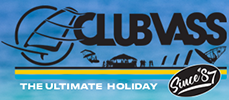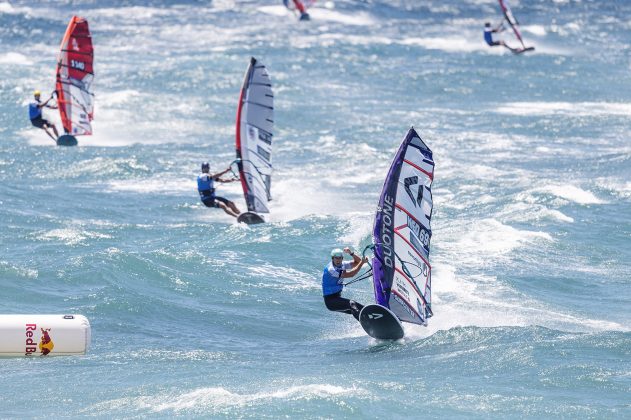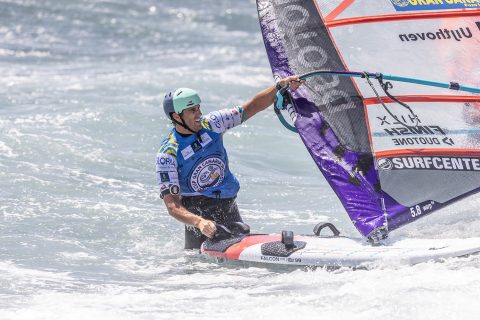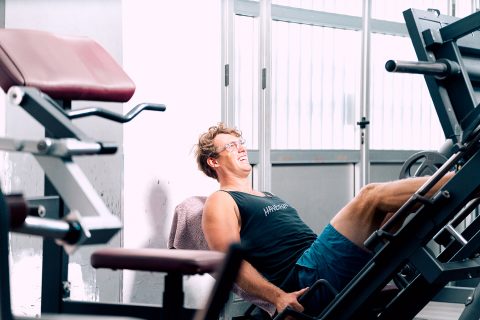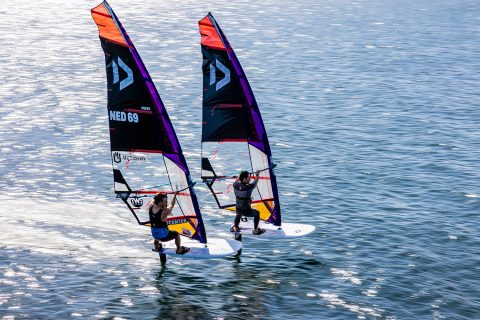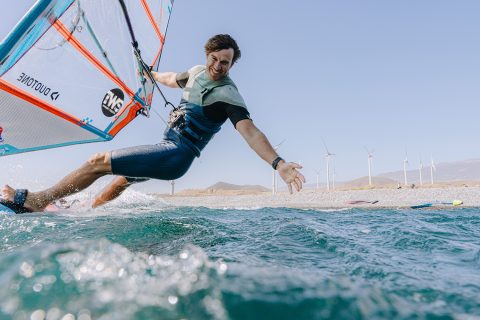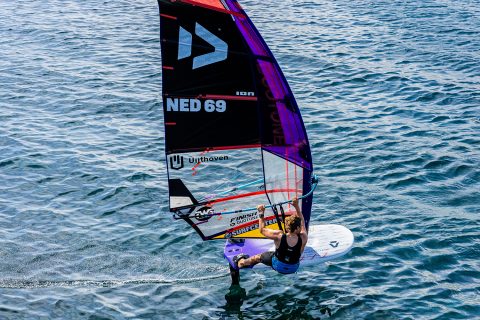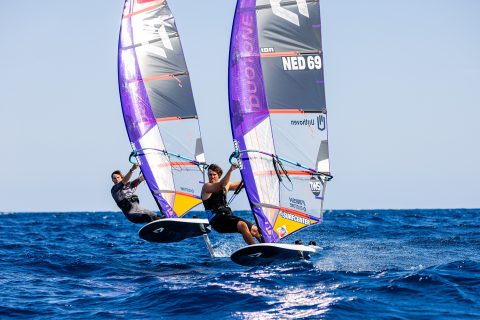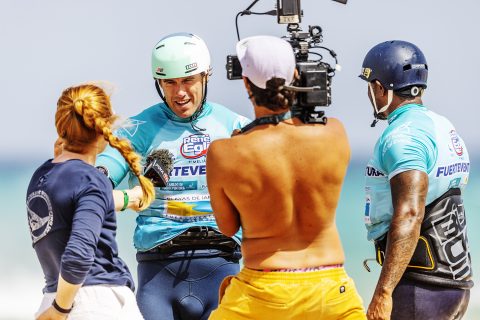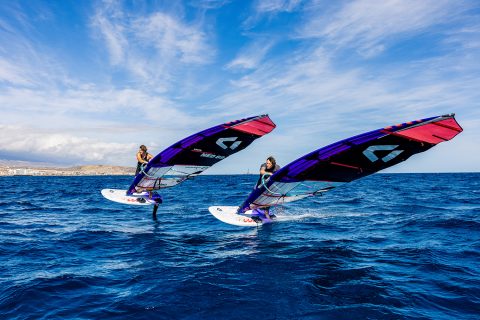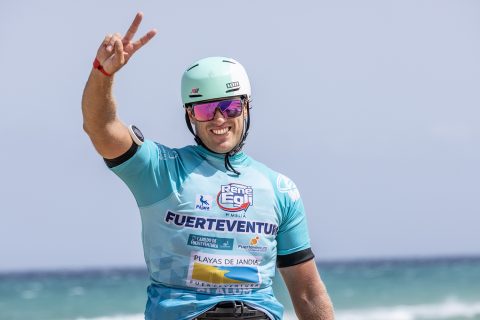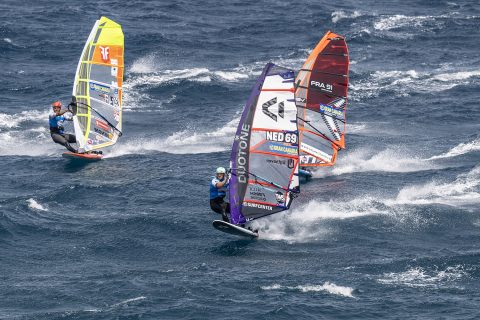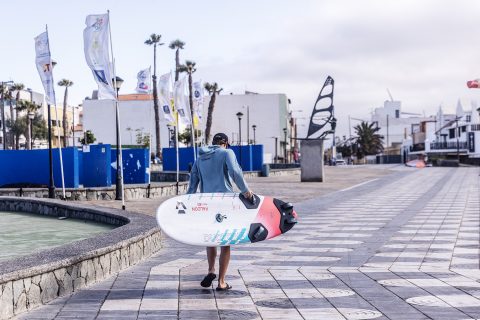OUT OF HIBERNATION: JORDY VONK
GEARING UP FOR THE RACE SEASON
It’s April at last, the temperatures are rising, and it is finally time to dust the cobwebs off your race gear and get back to doing what you do best: leaving the competition in your wake! Of course, some hardcore lunatics have been braving freezing conditions all winter, while the lucky pros have escaped to warmer destinations.
But for the rest of us mere mortals, it’s time to shed those extra winter kilos, rebuild those dwindling windsurfing muscles, and get race-ready. So, how do you make sure you’re not just keeping up but leading the pack? Fear not Duotone’s Jordy Vonk is here to share his top secrets on prepping for a full season of high-speed action!
How do you get back into physical shape for both on and off the water after Christmas and the season break?
JV: Even though I take an off-season, which is about six weeks around December, I always stay active. I tell my physical coach not to create a strict program for me during this time. Instead, I work out freely, doing what I feel like, so it doesn’t feel like a chore. I also allow myself to indulge a bit more in food and alcohol. This year, I arrived in Tenerife in January and gradually increased my time on the water, which naturally helped improve my physical shape.
- Are you race ready?
Are you aiming for a specific weight for racing this season?
JV: Yes, I aim to be over 100 kg for Guadeloupe since I expect winds for 7.5 / 6.4 m² sails. Being slightly heavier is an advantage in those conditions. Right now, I’m at 104 kg, so I’m on track! After Guadeloupe, I’ll aim to lose a bit for the SlalomX events in the summer.
- Burning off those calories in the gym
How do you organize a schedule for a new season?
JV: For the past 12 years, January through March has been the same: Tenerife; it truly feels like my second home. After that, my priority is the PWA calendar, as those are the key events. Around those dates, I schedule everything else: R&D trips, photoshoots, national events, clinics, and tuning trips. It’s always a packed schedule!
- Jordy and Daniele race training
What does your training program look like, both on and off the water?
JV: I have a physical trainer who designs my off-water training and logs everything in an app for me to follow daily. My schedule usually includes 3-4 strength sessions and a couple of endurance workouts, though I personally prefer strength training. On the water, it varies. In the winter, at the TWS Pro Slalom Training, we race four times a week, which is excellent practice. The rest of the time, I focus on fine-tuning my gear to ensure I’m ready for upcoming events.
- Gearing up for the season
Do most sailors have the financial means to make this a full-time commitment?
JV: Not really. Many sailors have side jobs to support themselves. Of course, some manage to be full-time windsurfers, but nowadays, you have to be creative to make it work. Running clinics, for example, is a great way to earn extra income.
- Jordy in foil mode
KIT
Do you have new equipment to test and tune?
JV: Yes, every year, it’s the same process—testing new sails, often having doubles of some sizes to compare. I try different masts in various sails, experiment with board and sail combinations, and fine-tune my foil settings. With SlalomX and Slalom Foil as the two main racing disciplines, there’s even more to test! The maximum gear allowance for both disciplines combined is three boards and eight sails.
What maintenance needs to be done on older booms, ropes, etc.?
JV: This is crucial for both professionals and amateurs! I constantly check all ropes, boom head, outhaul system, extensions and replace them when necessary. The same goes for harness lines; I always inspect them inside and out because they might already be 80% worn through without looking damaged.
How do you test the speed of your gear and decide on the best settings for different conditions?
JV: Testing and taking notes is a daily routine. Whatever I learn on a given day might be useful in a competition later in the year. In Tenerife, I focus on fully understanding my gear, how different downhaul settings affect the sail, what changes in boom height or mast base position do, etc.
Once I have my best settings figured out in April, I head to Lake Garda to test all my masts and find the “golden stick” for the year. When I arrive at the first competition, I double-check my settings based on the local conditions. After that, I’m as ready as I can be!
Do you train with a partner to tune Duotone boards and sails?
JV: Before Guadeloupe, I always check in with my teammate Daniele Benetti to fine-tune my foil setup. It’s great to have someone on the same brand to compare notes with. Otherwise, it depends on who’s available, over the past few years, I’ve worked with different people.
- Testing and training in Tenerife
How do you divide your training time between fin and foil?
JV: It’s tough to say precisely. I tend to train more on the foil because that’s where I can still improve the most. The summer racing calendar is still TBD, but if SlalomX events happen in the Canary Islands, I’ll focus more on foiling before Guadeloupe. After that, I’ll switch to the fin for Defi Wind and other slalom events, then back to the foil again for Sylt, China, and Japan.
- That winning feeling
When do you test your speed against sailors from other brands?
JV: Ultimately, I need comparisons, like racing against Amado Vrieswijk, who uses different brands to know how fast I really am. It would be unlucky if we both turned out to be slow! But competing against sailors from other brands happens all the time, even during casual training. No matter the time of year or situation, you always keep an eye on your speed relative to the competition.
- Perfecting those gybes during a winter training trip in Tenerife
Is testing already underway for the 2027 equipment?
JV: Right now, we’re finalizing the 2026 racing equipment, which is both exciting and frustrating because I’d love to take it straight to competition! Once that’s done, it’s only a matter of time before we start on 2027 gear. The process never stops!
RACE READY
- Jordy Vonk Race ready!
What are your goals to be race-ready?
JV: The goal is confidence, knowing that I have everything I need to win. I need to feel fast on all necessary sail sizes for a given event. That’s what gives me the mental edge going into a race.
Is everything tested and tuned? Are you at peak fitness?
JV: I wouldn’t say I’m the fittest guy on tour, but I’m heavy, which is what I want for Guadeloupe. Afterward, when I switch to the fin, I’ll need to work harder on endurance, so I’ll adjust my training accordingly.
Is your season fully organized with a clear game plan?
JV: I’m an organized guy, it’s evident in how I keep my van! I might not be the most creative free spirit, but having a structured schedule makes me feel most comfortable.
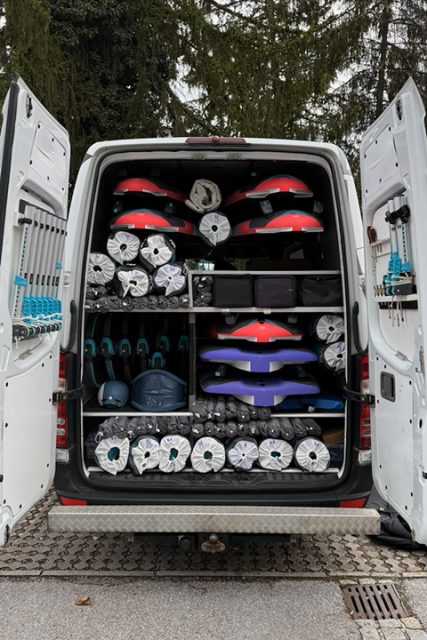
Are your finances, sponsorship agreements, and extra income sources sorted?
JV: The end of the year is always stressful, securing contracts and calculating budgets to get through the season. It has worked out for over a decade, but it’s never easy. I also schedule clinics depending on the PWA calendar, filling in gaps where possible. Fortunately, I enjoy hosting clinics, but they’re a financial necessity these days.
- Jordy flying on the fin
Mentally, are you ready for the season ahead? What are your goals?
JV: I feel great! This winter, I took a slightly different training approach due to time constraints, but I’m feeling especially strong on the foil.
For Guadeloupe in April, my goal is at least one podium finish and a top-five overall. The competition is fierce, and many sailors could make the podium, but I believe that if I race sharply, I can be one of them.
- The time is right!
As for SlalomX, I’m aiming for the title and, at minimum, a podium finish. I’ve finished fourth too many times, it’s time to break that streak! Last year, I was just one gybe away, so now I’m determined to take that final step. For me, it’s not a matter of if I can do it, but when I will.
- Race mode for Jordy
GEAR
There’s a reason Formula 1 teams show up with an army of mechanics to fine-tune their cars before a race. While you won’t need a pit crew for your windsurf setup, it’s still a technical sport, and taking good care of your gear is crucial. Regular check-ups can save you from unexpected problems on the water.
Gear Inspection Checklist
Find a spacious area in your garden, local beach, or anywhere you can rig everything up and go through the following checks:
Boards
✅ No hidden holes or deep scratches?
✅ Footstraps in good condition?
✅ Footstrap screws tightened properly?
✅ Mast base free from stress marks?
✅ Fins fitting securely?
Boom
✅ Ropes (outhaul and boom head) in good shape?
✅ Harness lines checked (open them up to inspect)?
✅ Uphaul line intact?
Sails
✅ No holes in the monofilm?
✅ No damage to the mast sleeve?
✅ All battens intact?
✅ Top cap securely in place inside the sail?
Mast
✅ No hidden cracks or cuts?
Final Pre-Season Prep
Once you’ve checked everything, rig your sail and fine-tune your settings. If you spot any defects, now is the perfect time to replace or repair them.
Skipping this step could mean showing up at the beach, pumped for your first session, only to find yourself stuck onshore or worse, swimming back because of a broken piece of gear!
If everything looks good, you’re all set, have an epic first session of the season!
- If you are not race ready you might as well head home!

